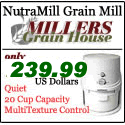|
|
Some Facts on Bread
Kadence Buchanan
During a recent trip to San Francisco I came across the most famous sourdough bread made in the U.S.; the San Francisco Sourdough. This bread has remained in production for nearly 150 years and combined with an amazing soup that is placed inside the bread, it constitutes today one of the most popular dishes of the West U.S. Coast.
In general, bread has been around for centuries. Experts believe that its origins started nearly 12,000 years ago. As one of the oldest prepared foods, bread is dating back to the Neolithic era. The first breads produced were probably cooked versions of a grain-paste, made from ground cereal grains and water and shaped into loaves that were laid on heated stones or baked by covering with hot ash. Descendants of these early breads are still commonly made from various grains worldwide, with the Mexican tortilla, Indian chapati, Chinese poa ping, Scots oatcake, North American johnnycake, and Ethiopian injera all being examples. However, the earliest documentation traces bread to the Middle East, where Egyptians cultivated grains. They baked flat breads, which are still eaten today, for many centuries until the discovery of fermentation at least three thousand years ago.
The technique of fermentation, which causes bread to rise, spread to all countries bordering the Mediterranean. This sparked new improvements with the development of clay ovens and the introduction of the rotary mill in 1,000 BC. These advances spread to other civilizations including African, Asian, Indian and much later American cultures.
Bread became so important that the bread industry began being controlled by those in power in the 11th century, by price and weight regulation. With further developments in agricultural machinery greater crop yields were realized. Hence, bakers headed towards the towns.
Otto Frederick Rohwedder is considered to be the father of sliced bread. In 1912 Rohwedder started work on inventing a machine that sliced bread, but bakeries were reluctant to use it since they were concerned the sliced bread would go stale. It wasn't until 1928, when Rohwedder invented a machine that both sliced and wrapped the bread, that sliced bread caught on. A bakery in Chillicothe, Missouri was the first to use this machine to produce sliced bread.
For generations, white bread was considered the preferred bread of the rich while the poor ate dark bread. However, the connotations reversed in the 20th century with dark bread becoming preferred as having superior nutritional value while white bread became associated with lower class ignorance of nutrition.
Kadence Buchanan writes articles on many topics including
Food, Travel, and Tennis
|
Our Food Supply is in Peril! Watch this
Video...
WE RECOMMEND

Here are even more informative articles on milling grains and whole wheat.
All About Baking: Quick Breads
Troubleshooting Machine Bread
Should You Bake Your Own Bread?
Organic Food: As healthy as you can get
The Health Benefits of Oats
Baking Ideas for Summer Foods

Nutrimill
Multi-Texture High Speed Grain Mill
BEST
PRICE Available! New and innovative
variable high speed grain mill. Mill grains and beans
into fresh flour in minutes. Get
More Information and Secure ORDER HERE See
Our Special! |
|